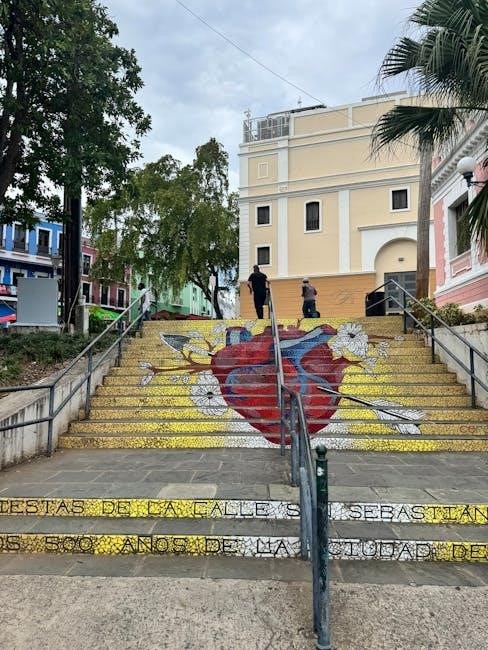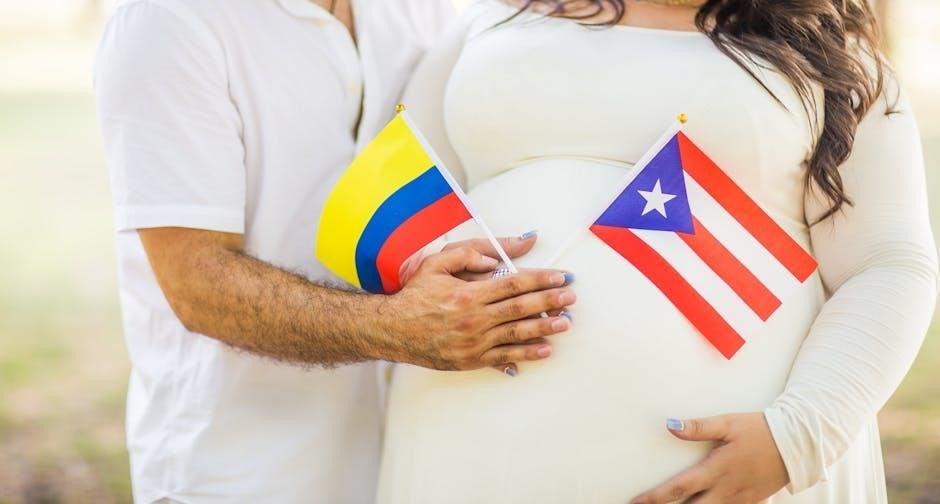When I Was Puerto Rican is a vivid and lyrical memoir by Esmeralda Santiago, recounting her journey from a rural Puerto Rican childhood to a challenging transition in New York City․ The narrative explores themes of identity, culture, and resilience, offering a deeply personal and universal story of growth and self-discovery․

1․1 Overview of the Memoir
When I Was Puerto Rican is a deeply personal and evocative memoir by Esmeralda Santiago, first published in 1993․ The book recounts Santiago’s childhood in rural Puerto Rico, where she grew up surrounded by vibrant culture, family traditions, and the natural beauty of the island․ The memoir captures the warmth of her early years, marked by the sounds of tree frogs, the taste of guavas, and the resilience of her family despite poverty․ It also explores the challenges of her transition to New York City at the age of 13, where she faced cultural shock, language barriers, and the struggle to adapt to a new environment․ The memoir bridges the gap between Santiago’s idyllic yet tumultuous past in Puerto Rico and her journey toward self-discovery in the United States, offering a poignant reflection on identity, cultural hybridity, and the immigrant experience․ Santiago’s lyrical prose brings her story to life, making it a powerful exploration of belonging and resilience․
1․2 Author Background: Esmeralda Santiago
Esmeralda Santiago is a celebrated Puerto Rican author, born in 1948 in San Juan, Puerto Rico․ She moved to the United States at the age of 13 with her mother and siblings, settling in Brooklyn, New York․ Santiago’s early life was marked by the cultural richness of Puerto Rico and the challenges of adapting to a new country․ She attended New York City’s High School of Performing Arts, where she majored in drama and dance․ Later, she pursued higher education part-time while working, eventually graduating from Harvard University․ Santiago’s writing often reflects her experiences navigating two cultures, blending vivid storytelling with deep emotional insight․ Her memoirs, including When I Was Puerto Rican and Almost a Woman, have gained critical acclaim for their lyrical prose and authentic portrayal of the immigrant experience․ Her work has significantly contributed to Latinx literature, offering a powerful voice on identity, resilience, and cultural hybridity․
1․3 Historical Context of Puerto Rico
Puerto Rico’s history is marked by its status as a Spanish colony for nearly four centuries, followed by U․S․ governance after the Spanish-American War in 1898․ This transition deeply influenced the island’s cultural identity, blending Spanish traditions with American policies; The colonial period shaped Puerto Rico’s language, religion, and social structures, while the U․S․ era introduced English education and economic changes․ Mid-20th-century initiatives like Operation Bootstrap spurred industrialization, prompting migration to the mainland, including Esmeralda Santiago’s family․ This historical backdrop frames Santiago’s memoir, exploring themes of cultural shift and identity amidst political and social evolution․ The historical context underscores the challenges and transformations Puerto Ricans faced, resonating through Santiago’s personal narrative of resilience and adaptation․
Early Life in Puerto Rico
Esmeralda Santiago’s early life in rural Puerto Rico was marked by vibrant cultural traditions, poverty, and a close-knit family; Her childhood memories include tropical landscapes, guava trees, and the sounds of nature, blending warmth with hardship․
2․1 Childhood in Rural Puerto Rico
Esmeralda Santiago’s childhood in rural Puerto Rico was a tapestry of vibrant cultural traditions and natural beauty․ Growing up in a small village, she experienced the simplicity of rural life, surrounded by mango groves, guava trees, and the rhythmic sounds of tree frogs․ Her early years were shaped by the warmth of her family and the rich cultural practices passed down through generations․ Santiago vividly recalls learning the proper way to eat a guava, the significance of traditional foods like morcilla, and the cultural rituals that marked daily life․ Despite the poverty and domestic challenges, her childhood was filled with sensory richness and a deep connection to her Puerto Rican heritage․ These formative experiences laid the foundation for her identity and resilience, which would later guide her through the transition to a vastly different life in New York City․
2․2 Family Dynamics and Cultural Influences
Esmeralda Santiago’s family life in rural Puerto Rico was marked by both tenderness and turmoil․ Her mother, Mami, was a central figure, embodying strength and resilience despite the challenges of poverty․ The large household, filled with siblings, was a hub of activity, with traditional gender roles and cultural expectations shaping daily interactions․ Santiago vividly portrays the complexities of her family relationships, highlighting the tension between love and conflict․ Cultural influences were deeply ingrained, with practices like preparing traditional foods, celebrating rituals, and adhering to societal norms playing a significant role․ These dynamics not only shaped Santiago’s identity but also fostered a sense of community and belonging․ The interplay between family life and cultural traditions provided a rich, albeit sometimes fraught, foundation for her early years, influencing her perspective on heritage and resilience as she navigated a rapidly changing world․ These experiences remain central to her narrative, offering insight into the intersections of culture, family, and personal growth․
2․3 Traditional Practices and Beliefs
Esmeralda Santiago’s memoir vividly captures the traditional practices and beliefs that shaped her childhood in rural Puerto Rico․ From learning the proper way to eat a guava to the sounds of tree frogs in mango groves, these customs were woven into daily life․ The memoir highlights the significance of cultural rituals, such as the formula for ushering a dead baby’s soul to heaven, reflecting a deep spiritual connection․ Traditional beliefs, including the influence of Catholicism and folklore, played a central role in her upbringing․ These practices not only provided comfort but also reinforced a sense of identity and community․ Santiago’s experiences illustrate how these traditions, passed down through generations, helped navigate the challenges of poverty and family life․ The rich cultural tapestry of her childhood serves as a testament to the enduring legacy of Puerto Rican heritage․ These traditions remain a vital part of her narrative, offering insight into the cultural and spiritual foundations of her early years․

The Move to New York City
Esmeralda Santiago’s move to New York City at 13 marked a dramatic shift from rural Puerto Rico․ Cultural shock, language barriers, and urban life challenged her identity, sparking a journey of adaptation and resilience․
3․1 Transition to Urban Life
Esmeralda Santiago’s move to New York City at the age of 13 marked a stark contrast to her rural Puerto Rican upbringing․ The transition to urban life was overwhelming, as she navigated a new environment vastly different from the tropical landscapes and close-knit family life she once knew․ Adjusting to the fast-paced city, she faced challenges such as overcrowded housing, cultural differences, and the pressures of urban schooling․ Despite these obstacles, Santiago’s resilience shone through as she learned to adapt to her new surroundings․ Her experiences in Brooklyn highlighted the struggles of immigration and the process of reconciling her Puerto Rican heritage with her growing American identity․ This period of her life became a defining chapter in her memoir, illustrating her determination to thrive in a world so different from the one she left behind․
3․2 Cultural Shock and Language Barriers
Esmeralda Santiago’s relocation to New York City exposed her to profound cultural shock and language barriers․ Moving from rural Puerto Rico to Brooklyn at the age of 13, she faced a stark contrast between the familiar rhythms of her homeland and the unfamiliar urban landscape․ The English language presented a significant obstacle, as she struggled to communicate in a system designed for English-speaking students․ Her limited proficiency led to initial misunderstandings and feelings of alienation․ Cultural differences further compounded her challenges, as she navigated customs, social norms, and educational expectations vastly different from those of her childhood․ Despite these hurdles, Santiago’s determination to adapt and learn became a defining aspect of her journey․ Her experiences vividly illustrate the struggles of immigration and the process of bridging two worlds while retaining her Puerto Rican identity․

3․3 Adaptation to a New Environment
Adapting to life in New York City was a transformative experience for Esmeralda Santiago, marked by both struggles and growth․ After overcoming initial language barriers, she embraced opportunities in her new environment․ Attending New York City’s Performing Arts High School, she excelled in drama and dance, discovering her passion for the arts․ Santiago’s resilience and determination to succeed drove her to adapt to the urban lifestyle while maintaining her Puerto Rican heritage․ Her journey reflects the challenges of immigration and the gradual integration into a new culture․ Santiago’s ability to navigate her dual identity became a source of strength, enabling her to thrive in her new home and eventually share her story through writing․ Her adaptation was not just about survival but about finding a sense of belonging in a world vastly different from her rural Puerto Rican roots․

Themes in the Memoir
When I Was Puerto Rican explores themes of identity, cultural hybridity, family dynamics, resilience, and the American Dream, weaving personal and universal struggles into a rich narrative of self-discovery and growth․
4․1 Identity and Belonging
In When I Was Puerto Rican, Esmeralda Santiago delves into the complexities of identity and belonging, reflecting on her journey from rural Puerto Rico to New York City․ The memoir captures her struggle to reconcile her Puerto Rican heritage with her new American surroundings, highlighting the tension between cultural roots and adaptation․ Santiago’s narrative vividly portrays her childhood in Puerto Rico, where she was deeply connected to her family and traditions, and her subsequent move to New York, where she faced cultural dislocation and language barriers․ This duality shapes her sense of self, as she navigates the challenges of belonging to two worlds․ The memoir serves as a poignant exploration of identity formation, illustrating how Santiago’s experiences of displacement and adaptation ultimately contribute to her understanding of herself and her place in the world․
4․2 Cultural Hybridity and Assimilation
When I Was Puerto Rican explores the intricate dynamics of cultural hybridity and assimilation through Esmeralda Santiago’s personal journey․ The memoir vividly captures her transition from a deeply rooted Puerto Rican culture to the unfamiliar landscape of American urban life․ Santiago’s experience of moving to New York City at the age of 13 exposes her to a starkly different world, where language barriers and cultural differences create both confusion and curiosity․ The narrative highlights her struggle to balance her Puerto Rican identity with the pressures of assimilation into American society․ This cultural hybridity is reflected in her adaptation of new customs, her bilingualism, and her evolving sense of belonging․ Santiago’s story illustrates the resilience required to navigate these dual worlds, ultimately blending her Puerto Rican heritage with her American experiences to forge a unique and enriching identity․ This theme resonates deeply, offering insights into the universal challenges and triumphs of cultural adaptation․
4․3 Family and Resilience
When I Was Puerto Rican profoundly explores the role of family and resilience in shaping Esmeralda Santiago’s life․ Her memoir vividly portrays the tight-knit bonds within her family, despite the challenges of poverty and domestic turmoil․ Santiago’s mother, Mami, emerges as a central figure, embodying both strength and complexity․ The narrative highlights the ways in which family unity and cultural traditions provided a sense of stability amidst adversity․ The move to New York City tests these bonds, as the family navigates a new and unfamiliar environment․ Santiago’s story illustrates how resilience is not just individual but also collective, as her family adapts to survive and thrive․ The memoir underscores the enduring power of familial love and the ways in which it sustains individuals through life’s hardships․ Through these experiences, Santiago’s journey becomes a testament to the strength of family and the human spirit’s capacity to persevere․ This theme is central to the memoir’s emotional depth and universal appeal․
4․4 The American Dream and Its Challenges
When I Was Puerto Rican delves into the complexities of the American Dream through Esmeralda Santiago’s experiences․ Moving to New York City as a teenager, Santiago faced cultural dislocation and economic struggles, challenging the idealized notion of upward mobility․ The memoir portrays the tension between the promise of opportunity and the harsh realities of poverty, language barriers, and discrimination․ Santiago’s journey reflects the resilience required to pursue a better life, yet it also critiques the notion that success is universally accessible․ Her eventual achievements, including educational and professional milestones, highlight the possibility of attainment but also underscore the sacrifices and struggles inherent in the process․ The memoir questions what the American Dream means for immigrants and marginalized communities, offering a nuanced exploration of aspiration, identity, and the true cost of assimilation․ Santiago’s story serves as a powerful commentary on the complexities of pursuing a better life in a society fraught with inequalities․

Literary Style and Structure
Esmeralda Santiago employs a lyrical narrative voice, weaving vivid imagery to recount her journey from Puerto Rico to New York, blending sensory details with symbolic elements that reflect her cultural identity and transition․
5․1 Narrative Voice and Perspective
The memoir When I Was Puerto Rican is narrated through the intimate and reflective voice of Esmeralda Santiago, offering a deeply personal account of her life․ Written in the first person, the narrative captures the innocence and curiosity of her childhood in Puerto Rico, while also conveying the confusion and resilience of her teenage years in New York․ Santiago’s voice is both lyrical and straightforward, blending vivid descriptions of her surroundings with emotional honesty․ Her perspective shifts seamlessly from the wonder of rural Puerto Rico to the disorientation of urban America, creating a vivid contrast between two worlds․ The narrative voice evolves alongside her journey, reflecting her growth from a naive child to a self-aware young woman navigating cultural identity․ This dual perspective—childhood innocence and adult reflection—adds depth and nuance to the storytelling, making the memoir a compelling exploration of identity and belonging․
5․2 Use of Sensory Details

When I Was Puerto Rican is rich in sensory details that immerse readers in Esmeralda Santiago’s experiences․ Santiago vividly describes the sights, sounds, and smells of her childhood in Puerto Rico, such as the sweetness of guavas, the fragrance of blooming flowers, and the rhythmic croaking of tree frogs․ These details evoke a strong sense of place, transporting readers to the lush landscapes and vibrant culture of her homeland․ In contrast, her portrayal of New York City is filled with the cacophony of urban life, the chill of winter, and the unfamiliar tastes of American food․ Santiago’s use of sensory language not only enhances the memoir’s emotional depth but also serves as a bridge between her two worlds, allowing readers to experience her journey of cultural transition firsthand․ This vivid imagery makes the memoir a sensory as well as an emotional journey, deeply engaging the reader’s imagination and empathy․
5․3 Symbolism in the Memoir
When I Was Puerto Rican employs rich symbolism to convey deeper meanings about identity, culture, and transformation․ Natural elements like guavas and mango groves symbolize the warmth and vibrancy of Santiago’s Puerto Rican heritage, while the stark contrast of New York City’s urban landscape represents her disconnection from that roots․ The journey itself—from rural Puerto Rico to bustling Brooklyn—is a metaphor for her transition from innocence to self-discovery․ The symbolic divide between her Spanish-speaking childhood and her English-speaking adolescence underscores her struggle to reconcile her dual identities․ Even the act of eating guavas, a simple yet evocative detail, symbolizes the loss of innocence and the passage from childhood to adulthood․ Santiago’s use of sensory imagery and cultural symbols creates a layered narrative that resonates with universal themes of belonging and transformation․ These symbols not only enrich the storytelling but also offer readers a profound connection to her emotional journey․
Reception and Impact
When I Was Puerto Rican has received widespread critical acclaim for its lyrical prose and profound exploration of identity․ It is widely studied in schools, bridging U․S․ and Caribbean literatures, and remains a significant work in Puerto Rican literature․
6․1 Critical Acclaim and Reviews
When I Was Puerto Rican has garnered significant critical acclaim for its lyrical prose and poignant exploration of cultural identity․ Reviewers praise Santiago’s ability to weave vivid sensory details into her narrative, creating a relatable and emotionally resonant story․ The memoir is celebrated for its honest portrayal of the challenges of immigration, cultural hybridity, and the quest for self-discovery․ Many have noted its importance in bridging U․S․ and Caribbean literatures, offering a unique perspective on the Puerto Rican experience․ The book’s emotional depth and universal themes have made it a favorite among readers and scholars alike; Its inclusion in educational curricula underscores its value as a tool for understanding the complexities of identity and migration․ Overall, the memoir is hailed as a powerful and evocative work that resonates deeply with readers from diverse backgrounds․
6․2 Cultural Significance in Puerto Rican Literature
When I Was Puerto Rican holds a pivotal place in Puerto Rican literature, offering a deeply personal yet universally relatable account of identity and migration․ Santiago’s memoir is celebrated for its authentic portrayal of rural Puerto Rican life, capturing the vibrant culture, traditions, and struggles of the island․ The book bridges the gap between U․S․ and Caribbean narratives, providing a unique lens through which to view the Puerto Rican experience․ Its exploration of cultural hybridity and assimilation resonates strongly within the diaspora, making it a cornerstone of contemporary Puerto Rican literature․ By sharing her story, Santiago has given voice to the experiences of many, fostering a greater understanding of the complexities of identity and culture․ The memoir’s impact is further amplified by its inclusion in academic curricula, ensuring its relevance for future generations․ It remains a testament to the resilience and richness of Puerto Rican heritage․

6․3 Educational Use in Schools and Universities
When I Was Puerto Rican has become a staple in educational curricula, particularly in schools and universities, for its rich thematic content and cultural significance․ The memoir is widely taught in high school and college courses, where it serves as a powerful tool for exploring identity, migration, and cultural hybridity․ Its vivid storytelling and relatable themes resonate with diverse student populations, fostering empathy and understanding of the Puerto Rican diaspora experience․ Educators often pair it with Santiago’s sequel, Almost a Woman, to provide a comprehensive view of her life journey․ The book’s inclusion in academic programs highlights its value in promoting cultural awareness and literary analysis․ Its availability as a free PDF further facilitates its adoption in educational settings, making it accessible for students to engage with Santiago’s poignant narrative․ This educational use ensures the memoir’s legacy continues to inspire future generations․
When I Was Puerto Rican leaves a lasting legacy as a powerful exploration of identity, culture, and resilience․ Its poignant narrative continues to inspire readers and remains a vital voice in Puerto Rican literature․
7․1 Legacy of the Memoir
When I Was Puerto Rican has left an enduring legacy in both Puerto Rican and American literature․ Its vivid portrayal of cultural identity, migration, and personal resilience has resonated deeply with readers․ The memoir bridges U․S․ and Caribbean literatures, making it a significant work in the immigrant narrative tradition․ Esmeralda Santiago’s storytelling not only preserves Puerto Rican culture but also sheds light on the challenges of assimilation․ The book’s emotional depth and sensory details have made it a beloved and educational resource, widely used in schools and universities․ Its exploration of identity and belonging continues to inspire new generations, cementing its place as a timeless and influential memoir in contemporary literature․
7․2 Personal Reflections on Identity
In When I Was Puerto Rican, Esmeralda Santiago offers profound personal reflections on identity, weaving her journey of self-discovery with the complexities of cultural duality․ She poignantly captures her emotional struggle of leaving Puerto Rico, grappling with the loss of her homeland while navigating the unfamiliar terrain of American life․ Santiago’s memoir is a deeply intimate exploration of how she reconciles her Puerto Rican heritage with her evolving American identity․ Her reflections reveal a constant negotiation between preserving her cultural roots and embracing her new surroundings, ultimately leading to a sense of empowerment and self-acceptance․ Through her story, Santiago invites readers to reflect on their own identities, highlighting the universal quest for belonging and the beauty of embracing a hybrid identity․ Her personal journey resonates with anyone who has ever felt torn between two cultures, offering a powerful testament to resilience and the richness of a multifaceted self․